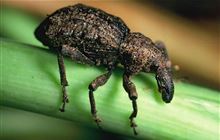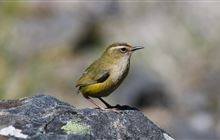New Zealand's threatened birds
Introduction
Find out which birds face the greatest risk of extinction.The following birds have been classified as Nationally Critical, Nationally Endangered or Nationally Vulnerable according to the New Zealand Threat Classification System (NZTCS).
On this page:
Threatened
At Risk
Threatened
Nationally Critical
Most severely threatened, facing an immediate high risk of extinction:
- Antipodean wandering albatross/toroa
- Australasian bittern/matuku-hūrepo
- Chatham Island black robin
- Black stilt/kakī
- Chatham Island oystercatcher/tōrea tai
- Chatham Island tāiko
- Gibson’s wandering albatross/toroa
- Kākāpō
- Kermadec white-faced storm petrel
- New Zealand fairy tern/tara iti
- Northern rock wren/pīwauwau
- Orange-fronted parakeet/kākāriki karaka
- Pacific white tern
- Salvin's mollymawk
- Shore plover/tuturuatu
- Southern New Zealand dotterel/tūturiwhatu
- Whenua Hou diving petrel
- White heron/kōtuku
Nationally Endangered
Facing high risk of extinction in the short term:
- Black-fronted tern/tarapirohe
- Chatham Island tomtit
- Forbes’ parakeet
- Kea
- Kermadec petrel “Summer”
- King shag/kawau
- Masked (blue-faced) booby
- Reef heron/matuku moana
- Rowi
- Southern falcon/kārearea
- Southern Fiordland tokoeka
- Southern rock wren/pīwauwau
- White-bellied storm petrel
- Yellow eyed penguin/hoiho
Nationally Vulnerable
Facing a risk of extinction in the medium term:
- Auckland Island shag
- Auckland Island teal
- Australasian crested grebe/pūteketeke
- Black noddy
- Black petrel/tāiko
- Blue duck/whio
- Brown skua
- Chatham Island shag
- Campbell Island snipe
- Chatham Island tūī
- Caspian tern/taranui
- Chatham Island pigeon/parea
- Chatham Island snipe
- Chatham petrel/ranguru
- Eastern rockhopper penguin
- Fiordland crested penguin/tawaki
- Foveaux shag
- Great spotted kiwi/roroa
- Grey duck/pārera
- Grey-headed mollymawk
- Haast tokoeka
- Hihi/stitchbird
- Hutton’s shearwater
- Lesser fulmar prion
- Light-mantled sooty albatross
- Long-tailed cuckoo
- New Zealand storm petrel
- Northern Fiordland tokoeka
- Northern royal albatross
- Pitt Island shag
- South Island kākā
- South Island takahē
- Southern royal albatross
- Southern white-fronted tern
- Spotted shag
- Stewart Island fernbird/mātātā
- Stewart Island weka
Nationally Increasing
Small but increasing population still facing a risk of extinction in the medium term:
- Antarctic tern
- Brown teal/pāteke
- Bush falcon
- Campbell Island teal
- Little spotted kiwi
- New Zealand dabchick
- North Island kōkako
- Northern New Zealand dotterel
- Otago shag
- Red-tailed tropicbird
- Wrybill
At risk
Declining
Population declining but still moderately common:
- Banded dotterel
- Banded rail
- Black-billed gull
- Buller's shearwater
- Eastern bar-tailed godwit
- Erect-crested penguin
- Fiordland crested penguin/tawaki
- Lesser knot
- Marsh crake
- New Zealand pied oystercatcher
- New Zealand pipit
- New Zealand white-capped mollymawk
- North Island fernbird
- North Island rifleman
- North Island robin/toutouwai
- Northern blue penguin
- Red-billed gull
- Sooty shearwater
- South Island fernbird
- South Island robin/kakaruai
- Southern blue penguin
- Southern Buller's mollymawk
- Spotless crake
- White-flippered blue penguin
- White-fronted tern
- Yellow-crowned parakeet/kākāriki
- Yellowhead/mohua
Recovering
Population increasing after previously declining:
- Australian little penguin
- North Island kākā/kākā
- North Island little shearwater
- Northern giant petrel
- Pied shag
- Pycroft's petrel
- Sooty tern
- South Island saddleback/tīeke
- Variable oystercatcher
Relict
Small population stabilised after declining:
- Antarctic prion
- Auckland Island banded dotterel
- Black shag
- Broad-billed prion
- Buff weka
- Chatham Island blue penguin
- Cook's petrel
- Fairy prion
- Flesh-footed shearwater
- Fluttering shearwater
- Grey noddy
- Grey petrel
- Grey-backed storm petrel
- Kermadec little shearwater
- Little shag
- Mottled petrel
- New Zealand white-faced storm petrel
- North Island saddleback/tīeke
- North Island weka
- Northern diving petrel
- Red-crowned parakeet/kākāriki
- Southern diving petrel
- Stewart Island robin/toutouwai
- Wedge-tailed shearwater
- White-naped petrel
Nationally Uncommon
Naturally small population and therefore susceptible to harmful influences:
- Antipodes Island parakeet
- Antipodes Island pipit
- Antipodes Island red-crowned parakeet
- Antipodes Island snipe
- Auckland Island pipit
- Auckland Island rail
- Auckland Island snipe
- Auckland Island tomtit
- Australian coot
- Black-fronted dotterel
- Bounty Island shag
- Campbell Island mollymawk
- Campbell Island shag
- Chatham fulmar prion
- Chatham Island fantail
- Chatham Island mollymawk
- Chatham Island red-crowned parakeet
- Chatham Island warbler
- Chathams pipit
- Codfish Island fernbird
- Fulmar prion
- Kermadec parakeet
- Kermadec petrel "Winter"
- Little black shag
- Northern Buller's mollymawk
- Poor knights bellbird
- Rakiura tokoeka
- Royal spoonbill
- Snares Cape petrel
- Snares crested penguin
- Snares fernbird
- Snares Island snipe
- Snares Island tomtit
- Soft-plumaged petrel
- Subantarctic little shearwater
- Three Kings bellbird
- Westland petrel
All birds
Conservation status of birds in Aotearoa New Zealand, 2021
By: Hugh A. Robertson, Karen A. Baird, Graeme P. Elliott, Rodney A. Hitchmough, Nikki J. McArthur, Troy Makan, Colin M. Miskelly, Colin. J. O’Donnell, Paul M. Sagar, R. Paul Scofield, Graeme A. Taylor and Pascale Michel
New Zealand Threat Classification Series 36. Department of Conservation, Wellington. 43 p. (PDF, 824K)


